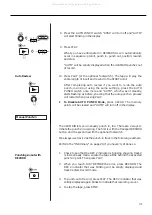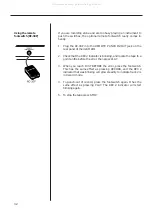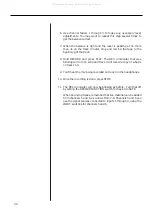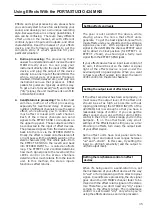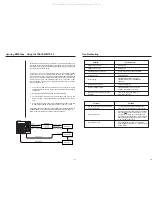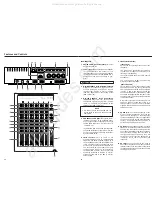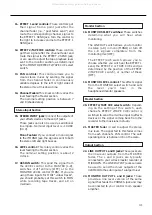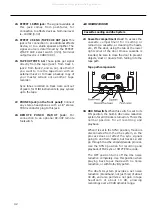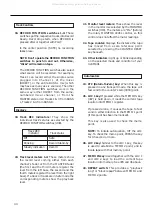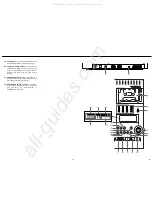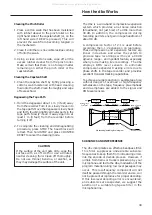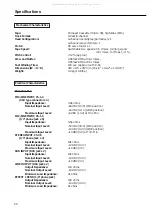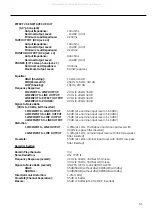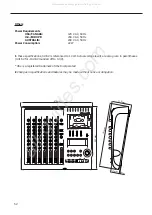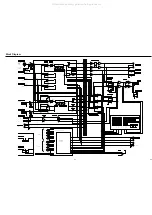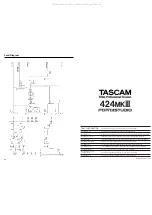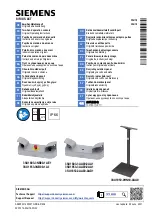
49
The dbx is a wide-band compression-expansion
system which provides a net noise reduction
(broadband, not just hiss) of a little more than
30 dB. In addition, the compression during
recording permits a net gain in tape headroom of
about 10 dB.
A compression factor of 2:1 is used before
recording; then, 1:2 expansion on reproduce.
These compression and expansion factors are
linear in decibels and allow the system to
produce tape recordings with over a 90 dB
dynamic range – an important feature, especially
when you're making live recordings. The dbx
employs RMS level sensors to eliminate
compressor-expander tracking errors due to
phase shifts in the tape recorder, and provides
excellent transient tracking capabilities.
To achieve a large reduction in audible tape hiss,
without danger of overload or high-frequency
self-erasure on the tape, frequency pre-emphasis
and de-emphasis are added to the signal and
RMS level sensors.
Cleaning the Pinch Roller
1. Press a cotton swab that has been moistened
with rubber cleaner to the pinch roller on the
right hand side of the capstan shaft (or, on the
left hand side if REW is pressed). This will
prevent the swab from becoming tangled in
the mechanism.
2. Clean it until there is no visible residue coming
off onto the swab.
3. Using a clean cotton swab, wipe off all the
excess rubber cleaner from the pinch roller.
Make certain that there is no foreign matter
remaining on either the pinch roller or the
capstan shaft.
Cleaning the Capstan Shaft
1. Clean the capstan shaft by lightly pressing a
cotton swab moistened with head cleaning
fluid onto the shaft. Clean thoroughly and wipe
off excess fluid.
Degaussing the Tape Path
1. Hold the degausser about 1 m (3 feet) away
from the recorder. Turn it on, slowly move in to
the tape path. Move the degausser slowly back
and forth, touching lightly all metal parts in the
tape path. Slowly move it away again to at
least 1 m (3 feet) from the recorder before
turning it off.
2. To complete the cleaning and demagnetizing
procedure, press STOP. The head block will
retract. Then hold STOP and press COUNTER
RESET to cancel the cleaning mode.
How the dbx Works
CAUTION
If the surface of the unit gets dirty, wipe the
surface with a soft cloth or use a diluted
neutral cleaning fluid. Clean off thoroughly.
Do not use thinner, benzine, or alcohol, as
they may damage the surface of the unit.
SUBSONICS AND INTERFERENCE
The dbx incorporates an effective bandpass filter.
This filter suppresses undesirable subsonic
frequencies to keep them from introducing errors
into the encode or decode process. However, if
rumble from trains or trucks is picked up by your
microphone and fed to the dbx, modulation of the
program material during low level passages may
occur. This low-frequency component will not
itself be passed through the recorder and so, will
not be present at reproduce for proper decoding.
It this low-level decoding error is encountered,
and subsonics are suspected, we suggest the
addition of a suitable high-pass filter in the
microphone line.
80dB
Input
Dynamic range
of
input signal
Encoder
Tape deck
Decoder
Output
Encode
(Compress)
40dB
40dB
Record Playback
Decode
(Expand)
80dB
Saturation
level
+20dB
+10dB
+15dB
+25dB
+20dB
0dB
Dynamic range of tape
(65dB)
–60dB
–60dB
–30dB
–50dB
–80dB Noise level
dbx
encoding/decoding level diagram
Á
Á
Á
Á
Á
Á
Á
Á
All manuals and user guides at all-guides.com

